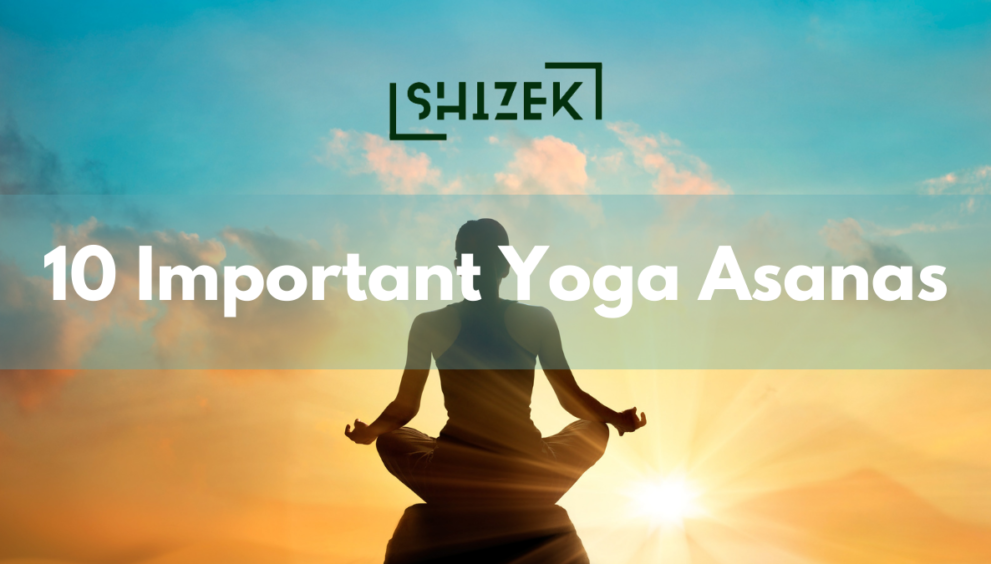Yoga Asanas Names With Pictures and Benefits

Yoga is an ancient practice that has been around for thousands of years. It not only helps to improve flexibility and strength but also has a calming effect on the mind and body. In this article, we will explore 10 different yoga asanas with pictures and benefits that can help you achieve a healthy mind and body.
Table of Content
- Mountain Pose (Tadasana)
- Tree Pose (Vrksasana)
- Warrior Pose (Virabhadrasana)
- Triangle Pose (Trikonasana)
- Child’s Pose (Balasana)
- Cobra Pose (Bhujangasana)
- Downward-Facing Dog Pose (Adho Mukha Svanasana)
- Seated Forward Bend (Paschimottanasana)
- Bridge Pose (Setu Bandhasana)
- Corpse Pose (Savasana)
Mountain Pose (Tadasana)

- Steps for Tadasana:
- Stand tall with feet together or hip-width apart, distributing weight evenly.
- Roll shoulders back and down, engaging the core muscles.
- Lift the chest and gaze forward, keeping the head in line with the spine.
- Benefits of Tadasana:
- Improves posture and body alignment.
- Strengthens the legs, ankles, and core muscles.
- Promotes a sense of grounding and stability.
- Tips and Tricks for Tadasana:
- Visualize a gentle lift from the crown of your head, lengthening the spine.
- Engage the quadriceps and draw the navel inward for additional core support.
- Precautions While Doing Tadasana:
- Those with balance issues may need to practice near a wall or chair for support.
Tree Pose (Vrksasana)

- Steps for Vrksasana:
- Begin in Mountain Pose, then shift weight onto one leg.
- Place the other foot on the ankle, calf, or inner thigh (avoid knee pressure).
- Bring palms together at the heart center for balance and focus.
- Gaze softly at a fixed point.
- Benefits of Vrksasana:
- Improves balance, concentration, and focus.
- Strengthens the leg muscles and ankles.
- Promotes mental clarity and calmness.
- Tips and Tricks for Vrksasana:
- Keep the standing leg rooted and engage the quadriceps for stability.
- Maintain a soft gaze and breathe deeply to aid balance.
- Precautions While Doing Vrksasana:
- Those with injuries or limitations in the legs or ankles should modify or avoid this pose.
Warrior Pose (Virabhadrasana)

- Steps for Virabhadrasana:
- Begin in Mountain Pose, step one foot forward, and turn the back foot at a 45-degree angle.
- Bend the front knee over the ankle, keeping the knee aligned with the ankle.
- Reach the arms overhead or parallel to the floor, gazing toward the front hand.
- Benefits of Virabhadrasana:
- Builds strength and stamina in the legs and core.
- Improves flexibility in the hips, shoulders, and ankles.
- Promotes a sense of empowerment and courage.
- Tips and Tricks for Virabhadrasana:
- Engage the quadriceps and core to maintain proper alignment.
- Keep the back heel firmly planted for stability.
- Precautions While Doing Virabhadrasana:
- Those with knee or ankle injuries should modify the depth of the pose or avoid it entirely.
Triangle Pose (Trikonasana)

- Steps for Trikonasana:
- Begin in Warrior Pose, then extend the front arm forward and the back arm back.
- Hinge at the hip, reaching the front hand toward the front foot, and the back hand toward the back.
- Keep both legs straight and engage the core.
- Gaze toward the front hand or up if comfortable.
- Benefits of Trikonasana:
- Improves flexibility in the hips, hamstrings, and spine.
- Strengthens the legs and core muscles.
- Promotes a sense of balance and stability.
- Tips and Tricks for Trikonasana:
- Keep the front foot anchored and the back heel firmly planted.
- Engage the core and maintain a straight line from the front heel to the back hand.
- Precautions While Doing Trikonasana:
- Those with neck or back injuries should modify the pose or avoid it entirely.
Child’s Pose (Balasana)

- Steps for Balasana:
- Start on your hands and knees, with knees hip-width apart and toes together.
- Sink your hips back toward your heels, extending your arms forward.
- Rest your forehead on the mat or a blanket, and breathe deeply.
- Benefits of Balasana:
- Releases tension in the back, shoulders, and neck.
- Promotes relaxation and reduces stress.
- Stretches the hips, thighs, and ankles.
- Tips and Tricks for Balasana:
- Use a blanket or bolster under your forehead for added support and comfort.
- Keep the arms extended or bring them back alongside the body.
- Precautions While Doing Balasana:
- Those with knee or ankle injuries may need to modify the pose or use props for support.
Cobra Pose (Bhujangasana)

- Steps for Bhujangasana:
- Lie on your stomach with legs extended and toes pointed back.
- Place your palms beside your ribs, with elbows tucked in close to the body.
- Inhale and gently lift your chest off the mat, keeping your navel on the floor.
- Gaze forward or slightly upward, being mindful of the neck.
- Benefits of Bhujangasana:
- Strengthens the back and shoulder muscles.
- Improves posture and spinal mobility.
- Expands the lungs and promotes deep breathing.
- Tips and Tricks for Bhujangasana:
- Engage the core and glutes to support the lower back.
- Keep the elbows tucked in to avoid strain on the shoulders.
- Precautions While Doing Bhujangasana:
- Those with wrist, shoulder, or lower back injuries should modify or avoid this pose.
Downward-Facing Dog Pose (Adho Mukha Svanasana)

- Steps for Adho Mukha Svanasana:
- Begin on your hands and knees, with hands shoulder-width apart and knees hip-width apart.
- Tuck your toes under and lift your hips up and back, straightening the legs.
- Engage the core and press the heels toward the mat, creating an inverted “V” shape.
- Keep the head relaxed, with gaze between the legs or toward the navel.
- Benefits of Adho Mukha Svanasana:
- Strengthens the arms, shoulders, and legs.
- Improves flexibility in the hamstrings, calves, and spine.
- Promotes blood circulation and relieves stress.
- Tips and Tricks for Adho Mukha Svanasana:
- Keep the hands shoulder-width apart and engage the core for stability.
- Pedal the feet or bend the knees if necessary for added comfort.
- Precautions for Adho Mukha Svanasana:
- Those with wrist, shoulder, or back injuries should modify or avoid this pose.
Seated Forward Bend (Paschimottanasana)

- Steps for Paschimottanasana:
- Sit upright with legs extended in front of you.
- Inhale and lift the arms overhead, lengthening the spine.
- Exhale and hinge forward from the hips, reaching for your toes or shins.
- Keep a slight bend in the knees if needed for comfort.
- Benefits of Paschimottanasana:
- Stretches the hamstrings, calves, and lower back.
- Promotes relaxation and reduces stress.
- Improves digestion and relieves constipation.
- Tips and Tricks for Paschimottanasana:
- Use a strap or towel to reach for your feet if flexibility is limited.
- Keep the spine elongated and avoid rounding the back.
- Precautions While Doing Paschimottanasana:
- Those with lower back or hamstring injuries should modify or avoid this pose.
Bridge Pose (Setu Bandhasana)

- Steps for Setu Bandhasana:
- Lie on your back with knees bent and feet flat on the floor, hip-width apart.
- Engage the core and glutes, and lift the hips off the mat, creating a straight line from knees to shoulders.
- Interlace the fingers underneath the back for added support.
- Gaze toward the ceiling or behind you if comfortable.
- Benefits of Setu Bandhasana:
- Stretches the chest, shoulders, and spine.
- Strengthens the back, glutes, and hamstrings.
- Improves digestion and relieves stress.
- Tips and Tricks for Setu Bandhasana:
- Engage the core and glutes to avoid straining the lower back.
- Use a block or rolled-up towel under the hips for added support.
- Precautions While Doing Setu Bandhasana:
- Those with neck or back injuries should modify or avoid this pose.
Corpse Pose (Savasana)

- Steps for Savasana:
- Lie flat on your back, with arms at your sides, palms facing up.
- Release any tension in the body and relax the muscles.
- Close your eyes and focus on your natural breathing.
- Remain in this pose for 5-10 minutes or longer.
- Benefits of Savasana:
- Promotes deep relaxation and reduces stress and fatigue.
- Calms the mind and relieves symptoms of anxiety and depression.
- Helps restore energy levels and aids in recovery after physical exertion.
- Tips and Tricks for Savasana:
- Use props like blankets or bolsters to support the body and enhance comfort.
- Visualize each part of your body consciously releasing tension.
- Practice deep abdominal breathing to quiet the mind.
- Precautions While Doing Savasana:
- Those with insomnia or difficulty remaining still may find this pose challenging initially.
- Ensure the environment is quiet, comfortable, and free from distractions.
Conclusion
Practicing yoga can have a significant impact on your overall health and well-being. It not only helps to improve flexibility and strength but also has a calming effect on the mind and body. Incorporating these 10 different yoga asanas into your daily routine can help you achieve a healthy mind and body. Remember to always listen to your body and practice within your limits.
Must Check Our Other Blogs on Yoga & Fitness























































































































